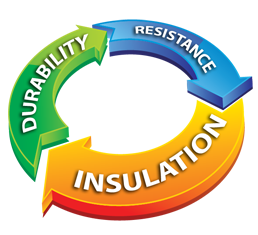100% Eco Friendly
Natural Raw Materials
Global Accepted Since Ancient Times
Proven Technology
Manufactured Using Continuous German Kilns, Till 1000oc
Highly Porous
High Strength
Very Bad Conductor Of Heat
Acts As A Thermal Insulator, To Create Green Structures
Prevents UV Rays And Other Harmful Radiations
Clay Tiles Are Advised On Medical Point Of View
Cost Effective


Brick wall provides good sound insulation property due to its dense structure. The thickness and density of brick will deaden noise transmission and will deflect noise from streets, neighbouring homes, and jet planes. The sound insulation of brick work is generally accepted as 45 decibels for a 4 1/2 inches thickness and 50 decibels for 9 inches for the frequency ranges from 200 to 2,000 Hz.

Clay possesses natural and infinite pleasant colours of burnt clays. Its colour formation is achieved through a complicated physic - chemical reaction during the firing process. In contrast to the colour of stained body, brick colour is permanent and will not fade during weathering process. Different clay compositions, firing temperatures, or kiln atmosphere can lead to different colours. Bricks and tiles are absolutely free of pollutants and allergens and thus especially compatible with humans and nature

Clay generally exhibits better thermal insulation property than other building materials like concrete. Perforation can improve the thermal insulation property of bricks to some extent. Besides, the Thermal Mass and moisture that the brick has absorbed can help to keep the temperature inside the house relatively constant. In other words, brick absorbs and releases heat slowly and thus keep the house cool during day-time and warm during night-time.

The fire resistance of a building material refers to the length of time a walling element is about to resist a fully developed fire. In every case, clay brick walls obtain maximum fire ratings. The fire resistance of a building material refers to the length of time a walling element is about to resist a fully developed fire. In every case, clay brick walls obtain maximum fire ratings. To the owner of a clay brick building, this means peace of mind and substantial savings over time on insurance premiums. Please refer to the table below for Design of Clay Brickwork for Fire.

Clay bricks do not require maintenance; you do not need to worry the clay brick from rotting, denting, warping, rusting, splitting, peeling, fading, and termites. As your home gets older, it naturally becomes more beautiful.

Clay building materials can be used for a variety of applications. They can be used for walls, façades and roofs as well as for gardens, terraces and open spaces. Clay tiles and bricks can be used almost anywhere and for all architectural styles, whether for the construction of single family houses or apartment blocks, office or public buildings.

Clay bricks and tiles are aesthetic and versatile. Thanks to a wide range of available colours, shapes and surfaces, the number of possible designs and variations is almost unlimited. The colour spectrum ranges from super white to classic red to coal-black. Available variants include rough, smooth and glazed surfaces, elongated and wide formats. Roof tiles and facing bricks as well as pavers can be perfectly coordinated with one another.

Owing to their excellent insulation properties and their heat storage capacity clay building materials help to reduce the energy consumption of buildings.

Clay building materials are robust, stable and, as a result, especially durable; their lifespan is more than 100 years. Brick buildings, which have lasted for centuries, can be discovered all around the world. Buildings made of clay tiles and bricks are weather-resistant, earthquake-proof and fire-resistant.

A solid building envelope made of brick can be constructed quickly and flexibly – this saves both time and money. Wind and weather, heat and frost are not able to damage clay building materials. As a result, maintenance and service costs are low. Owing to their favourable insulation properties, clay building materials also help to save energy costs.

Even after many years, buildings made of clay building materials retain their value - or it even increases. Owing to their durability, stability and special living quality, brick buildings and apartments are in great demand and achieve high resale values. Furthermore, bricks and tiles are easy-to-clean and low-maintenance.